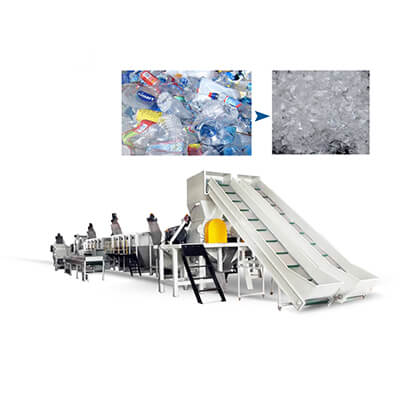© 2018 Zhangjiagang Sevenstars Machinery Co.,Ltd. All rights reserved. Site Map Designed by iwonder.cn privacy policy
Plastic recycling machine factory with 15 years experience
Plastic recycling machine factory with 15 years experience
There are several factors involved in the production and uses of PET that make it considered as a material that is not beneficial for the environment. Today's large production volumes of this material use considerable amounts of oil, a valuable, non-renewable source. And PET ends up in items that ultimately need proper disposal.
Here, we shall be looking at the PET recycling process.
The recycling systems
There are three ways to take advantage of PET packaging once its useful life has ended: subject it to mechanical recycling, chemical recycling, or energy recycling using them as an energy source using the equipment such as the PET plastic bottle recycling machine.
In order to maximize the utility that plastics produce, techniques have been developed that separate them according to their types. These techniques are grouped into the following categories:

- Macro-selection of components:
It is the primary task that allows to select and group manually or automatically the discarded articles according to their nature and destination. An example of this is the separation of the PET bottles that are used in soft drinks from the HD-PE that are used in milk packaging.
- Micro-selection of components:
The annotated micro-selection involves separating the polymers according to their types, after they have been cut and crushed into small pieces. Currently commercial micro-separation is applied to PET soft drink bottles since it is possible to crush the bottle and separate the pieces of PET and PE-HD and PP to obtain a high quality product. This procedure involves using a flotation technology extracted from the mining industry in which the materials are separated by flotation taking advantage of the differences in density.
- Molecular selection:
This recycling method consists of separating the polymers, for example some modern packages that have one or more of them, by dissolving them in a solution. The procedure is based on the dissolution temperature of each polymer, which in the end allows them to be recovered in layers.
Mechanical recycling
It is the most widely used recycling process, which consists of several stages of separation, cleaning and grinding.
The chosen and thickly cleaned plastics (labels, papers, biodegradable material residues) go through a mill or a shredder. This process can be carried out in different orders of succession, depending on the degree of contamination of the plastics and the quality of the recycled product.
The final preparation of the product begins with the washing and the separation of contaminating substances, a process that can be repeated if necessary. The material then goes through a centrifuge and dryer and is stored in an intermediate silo. In the ideal case, this silo also serves to further homogenize the material, in order to obtain a constant quality. However, the PE, PP washing recycling line cost varies according to the amount of materials to be recycled.
The crushed, clean, dry and homogeneous product is fed to an extruder, and, after the blasting process, the pellets are obtained, ready to be processed by different techniques. Recycled plastic pellets can be used in different ways, depending on the requirements for the final product.
-Processed directly recycled product, with the formulation that is appropriate to your specific application. In this case, the pieces obtained from the plastic recycling granulating line generally have lower properties than those made with virgin polymer, which is sufficient for the desired utility.
-Mix of recycled pellets with virgin polymer to achieve the required performance. The typical example is the addition of virgin polymer to the thermoplastic mix.
-Coextrusion of the recycled product. An example of this technique is the manufacture of containers for detergents, in which the intermediate layer can be made from recycled polymer and the inner layer (product contact) and the outer layer are made of virgin polymer.